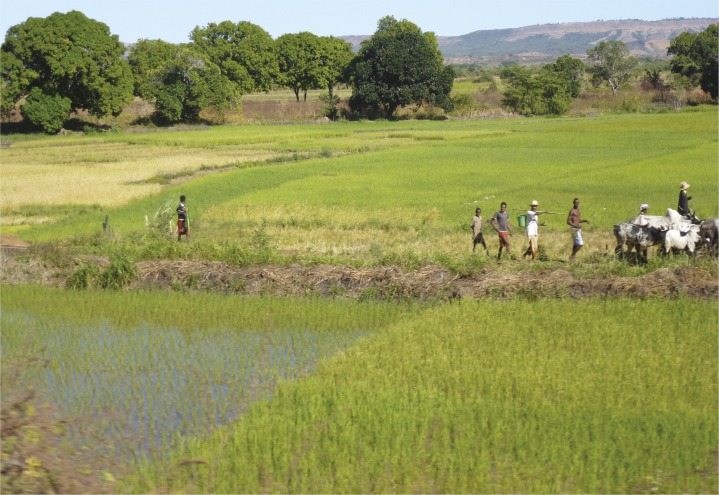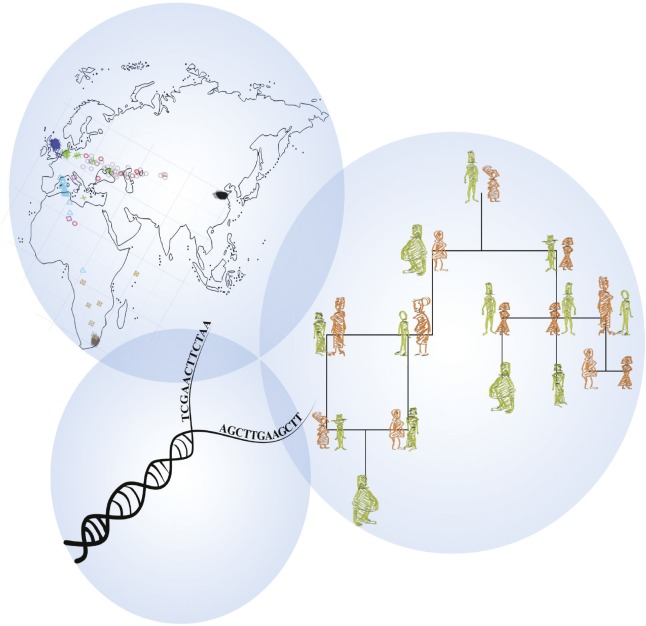Crop record of Austronesian expansion
Rice fields in Madagascar.
Although the island of Madagascar lies only 300 miles from continental Africa, the Malagasy people speak an Austronesian language associated with Southeast Asia and Pacific island nations around 3,600 miles to the east. Genetic and cultural investigations support an Austronesian origin for the Malagasy people, but no direct archaeological evidence establishes an early Southeast Asian presence in the region. Alison Crowther et al. (pp. 6635–6640) present an archaeobotanical analysis comprising 2,443 identified plant remains recovered from the main island, the East African mainland coast and nearshore islands, and the Comoros. The findings date agricultural sites dominated by the Asian crops rice, mung bean, and cotton, on Madagascar and Comoros to roughly between 700 and 900 CE. The findings also reveal geographically distinct locations on the African mainland and near coastal islands where the inhabitants primarily cultivated African fruits and grains, such as baobab, sorghum, and millet. According to the authors, the patterns suggest a complex early settlement history for Madagascar and raise the possibility that Madagascar may have been colonized indirectly by Austronesians who first settled on nearby islands or East Africa. — T.J.
Psychological interventions and college achievement gaps
Alumni Hall at Saint Anselm College in Manchester, New Hampshire. Image courtesy of Wikimedia Commons/Ericci8996.
In the United States, students from socioeconomically disadvantaged backgrounds fail to complete college at disproportionately high rates, even when their academic qualifications are similar to those of privileged students. In a series of three experiments comprising more than 9,500 participants, David Yeager et al. (pp. E3341–E3348) tested whether providing students with a positive lay theory—a belief that challenges associated with the transition to college are common and not indicative of one’s chances of success—before matriculation could reduce socioeconomic and racial/ethnic achievement gaps. Matriculating students at a high-quality 4-year public university and at a selective private university received interventions designed to teach a positive lay theory. At the public university, 73% of disadvantaged students who received the intervention remained enrolled full-time during the first year, compared with 69% of students who did not receive the intervention. Disadvantaged students at the private university who received the intervention had a mean first-year grade point average 0.09 points higher than controls and were less likely to place in the bottom 20% of the class. Disadvantaged students exiting an urban charter school network and who received intervention were nine percentage points more likely than controls to be full-time students one year later. Follow-up surveys suggested that students who received the intervention were more likely to become socially and academically integrated into college life, according to the authors. — B.D.
Genetic and phenotypic trends in the US population
Effects of changing mating and fertility patterns on genetic makeup of US population. Image courtesy of jeshoots.com/Jan Vašek.
Nonrandom mating and differential fertility among genotypes can alter the genetic makeup of a population. The extent to which these processes have affected the US population remains unclear. Dalton Conley et al. (pp. 6647–6652) examined variation in educational attainment, height, body mass index, and depression, along with variation in genes associated with these traits, across birth cohorts in more than 2,000 white, non-Hispanic spousal pairs from the US Health and Retirement Survey. The authors observed that educational attainment was more similar between spouses from later birth cohorts, compared with earlier cohorts. This trend was not reflected in genes associated with educational attainment; the similarity between spouses with respect to education-associated genes did not vary significantly across cohorts. The authors also noted that the difference in fertility between well-educated and poorly educated individuals increased over time. However, no such trend was observed between fertility and education-associated genes. No significant trends in spousal similarity or fertility were observed with respect to the other traits studied or the corresponding genotypes. The results do not support the view that increasingly nonrandom mating and decreasing fertility associated with certain traits have led to changes in the genetic makeup of the US population, according to the authors. — B.D.
Whole-exome sequencing and population substructure
WES facilitates prediction of population substructures and familial linkage analysis.
Single-nucleotide variant (SNV) arrays allow geneticists to scan whole genomes for common DNA variants associated with disease. This approach is also widely used to generate genotype datasets for a statistical method called principal component analysis (PCA), which can help discern associations between genes and traits. Further, the arrays are used to perform linkage analysis and to estimate homozygosity rates, an indicator of consanguinity and genetic disorders associated with inbreeding. Aziz Belkadi et al. (pp. 6713–6718) compared data from genome-wide SNV arrays (GWSAs) with whole-exome sequencing (WES), a technique that seeks disease associations in the subset of DNA that encodes proteins. Based on analysis of 110 volunteers worldwide, the authors show that PCA applied to WES data accurately predicts population substructures for variants with a minor allele frequency greater than 2%. WES also yields homozygosity rates that correlate highly with estimates derived from GWSAs. Using WES for homozygosity mapping leads to powerful linkage analyses, particularly for protein-coding regions, by nearly doubling the information provided by GWSAs. The findings demonstrate that WES offers potential benefits in linkage analyses, according to the authors. — T.J.






